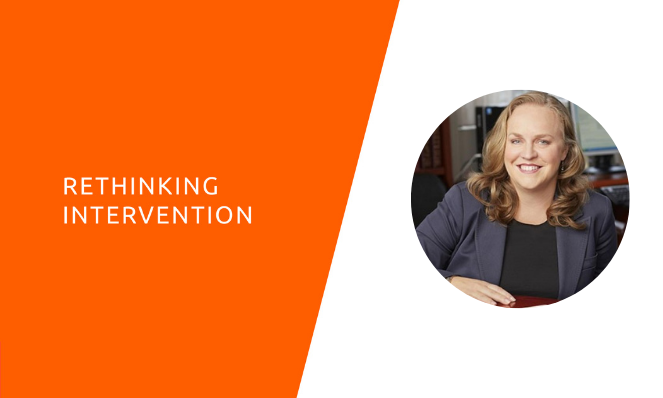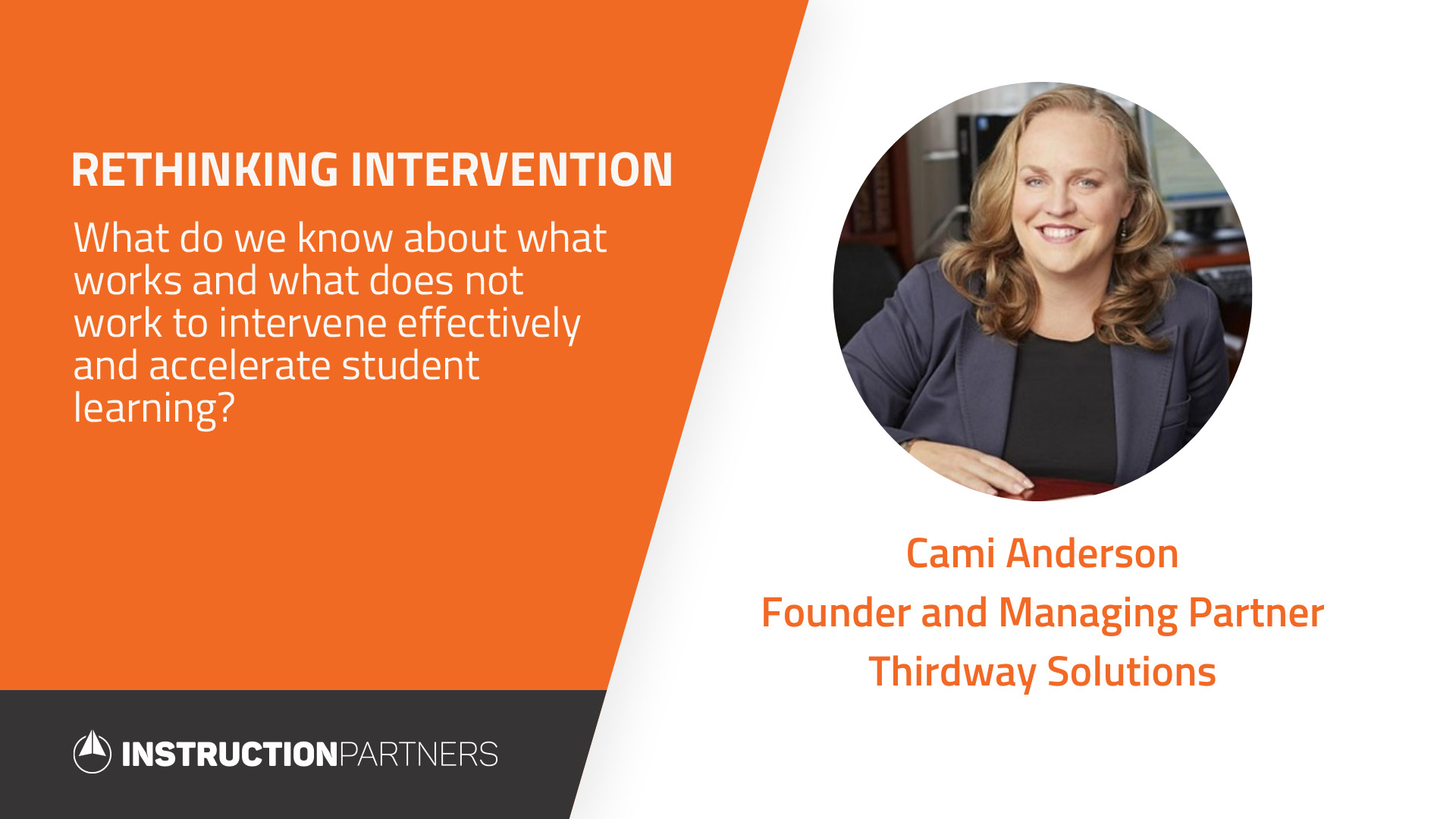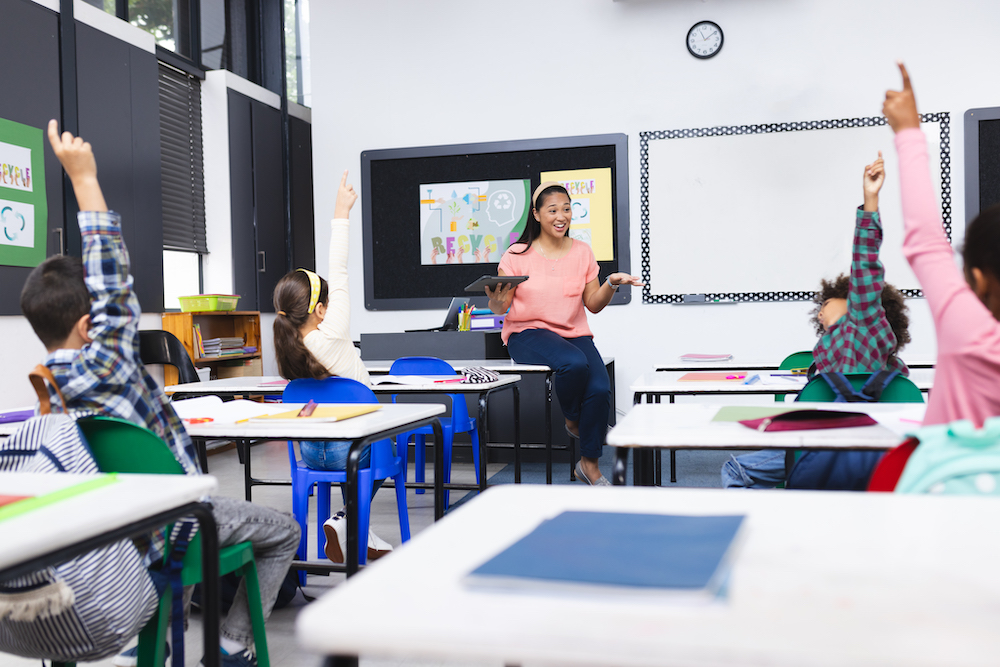
Cami Anderson, ThirdWay Solutions
Cami Anderson leads and founded ThirdWay Solutions, an organization dedicated to finding innovative solutions to problems facing government, non-profit, corporate, and philanthropic organizations in pursuit of equity.
Prior to Thirdway, she served as a superintendent of schools for nearly 10 years, first in New York City and then in Newark, where she received national attention for improving student outcomes and pushing innovation.
Cami spoke to Emily Freitag about the importance of the “fourth leg of the stool”—building trusting relationships and supporting safe learning spaces for students.
Watch the full conversation or read the abridged Q&A below.

EF: Please start by telling us your own journey as a learner and a student and what that has taught you about education.
CA: My journey to becoming an educator starts in my living room. I am one of 12 kids. I have nine adopted siblings. Only one joined us from birth and the rest came from the only system I think is more broken than public education, which is child welfare. My dad was an organizer in Watts and my mom was a family support specialist. We had one working bathroom. Nine of us are within three years of one another in age, and the white, non-differently-abled, heterosexual folks were the minority in my house. I grew up in what I probably would describe now as a “therapeutic learning community.” Of course, I didn’t have the language for that then. In my family, my folks very much modeled how to build trusting relationships, talk very openly about identity, race, ableism, create restorative circles when an incident occurred, and just self-awareness in general. I was keenly aware, at a young age, that school was different for my non-white siblings who also had disabilities, and from a very young age I saw that was incredibly unfair. That led to my journey to join Teach for America and ultimately to being in this work all these years. My North Star has always been the following: what would a school system look like where all of my siblings, and now all of my nieces and nephews who are also a diverse and awesome group, really thrived and excelled? I bring my living room with me everywhere I go. It really keeps me honest and keeps me focused on what’s right.
EF: Across your experience as an educational leader, as a researcher, as a thinker, as a practitioner, what do you feel like you have learned that works in education?
CA: I have always been very focused on what I call “the fourth leg of the stool,” which is sort of anything that you can’t categorize as operations, talent, and content. Operations include making sure that in your classroom, in your school, in your district, the trains are running on time, you have good budget systems, etc. Talent is making sure you have the right people in the right seats. Content is high-quality, rigorous, culturally-competent content—which is obviously critical and without it kids can’t learn. My passion, which is the thing I think we miss too often in our field and is something that I’ve thought about from the beginning of my teaching career, is around what I’m increasingly calling “the fourth leg of the stool.” This is how we build deep trusting relationships with students where they feel seen and heard, and where we’re able to really see them for who they are and what makes them tick. There are different things that make different students tick and ways of creating culture and community where students are leaders, where they have agency, and where they create norms and structures that they uphold and own. And then there are systems for addressing conflict and incidents—because I believe that what happens in moments of conflict in some way speaks as much about who we are as people and as educators as anything.
When I joined Teach for America, because of my family background, I volunteered to teach middle school students who’d been suspended for a year in a self-contained classroom with no school aide and no co-teacher. It was an extraordinary experience. I spent a good portion of my effort and energy building that fourth leg of the stool—building the community, the container, the norms, the leadership, and establishing trust with students who felt very put out by the system, who felt disenfranchised, who didn’t trust the system and didn’t trust adults. And it was because of that work, I believe that we were able to do really awesome work on academics. At that time in the education reform space, that was very countercultural. Now we have all these conversations about social-emotional learning and trauma-informed teaching. But at that time I think we had a misinformed theory of change that sort of said, if you get the right person in front of young people, and you give them the right materials, then everything will be fixed. That is not my lived experience from my living room, and it’s not my experience as an educator. In short, what works is thinking as rigorously, as deeply, and as carefully about how we build the right container or space for learning to occur as we do about our ELA curriculum. And I think that’s what we’re missing. By the way, I think that’s bad for all kids, but I think it’s really bad for the students for whom the existing system is not working, the students that we fail the most. It’ll lift all boats when we do it well, but we will not reach the young people that we’re all currently failing, including in our highest performing schools, unless we figure out this piece.
EF: One of the things we’ve been exploring is the different kinds of schools of thought within education about the best ways to do good work for students. Can you take us into SEL and trauma-informed education and map for us any schools of thought that you observe and what is good and challenging about those different approaches?
CA: First of all, we now have various pieces of solutions. And I’m happy to share sort of what I think is promising, but I think the big idea is that we shouldn’t have an antiracist workshop on Monday, a trauma-informed workshop on Tuesday, and an SEL workshop on Wednesday. One big flaw in our current approach is that it’s very fragmented. I believe that pieces of each of those movements or schools of thought have promising practices. The big mess that we have right now is A) we’re not putting it together in a way that feels comprehensive to change in a school or a classroom, and B) some of the solutions are very very technical, when this work is inherently adaptive, in the sense that it’s as much about shifting mindsets and beliefs as it is in policy and practice. It’s important that policy changes, but the real prize is changing mindsets, approaches, and educator practice.
I’ll walk you through a couple of things that are critical. One is I’m becoming increasingly passionate about breaking down the research about what constitutes trusting relationships between adults and students. We take for granted that folks know what that is. It’s hard and we’re not students’ friends, and yet we are authority figures and need a real focus on how power and race and other identities play out in informing those bonds and sometimes in perpetuating biases that exist in society. One concrete thing is really unpacking what does that mean? How do you become incredibly self aware as an educator about from whence you speak and how that interacts with students? And how do you make a real purposeful approach — across your school building — with everyone prioritizing the deep trusting relationships in the context of antiracism and anti-biased work. That’s one piece and we’re not doing enough of that. Frankly, I can’t point you to a great model because we’re still learning even how to unpack that. What doesn’t work is saying, “well, the guidance counselor has to be good at that, or the school resource officer has to be good at that” Everyone has to be good at that. Every educator in the building should be trained and supported around building trusting relationships and understanding their biases as much as they should around writing a good lesson plan. That’s one.
The second piece is really thinking through the norms and structures within the building that allow students to lead and create their own spaces. This might be therapeutic learning centers where young people can run affinity groups and have open space to talk to one another. Other methods involve having peer mediators or peer coaches who are trained in how to de-escalate conflict and also to model for other young people how to be in the space. There are lots of ways of thinking about culture and climate, both within individual classrooms and also within the school. Norms that are imposed by adults and come with “Either you do X, or we’re going to do Y” are least effective. It’s actually not a recipe to help students grow, change, and learn. I share the following with adults all the time: think about a time where you wanted to get in better shape or you wanted to lose weight. Here’s what doesn’t work: someone is in your face shaming you every time you eat a brownie, or miss your workout, or someone is saying to you, “You’re going to lose 10 pounds and if you don’t, we’ll put you out.” It’s just antithetical to what we know about behavior change. So that’s the norms piece.
The third piece is making sure that we have good high-quality content. This is where SEL comes into play, to allow students to learn and practice and internalize habits of mind that are useful. Everything from organizing themselves in their time, to managing and mediating conflict, to being active upstanders. As an example, teaching a student to be an upstander, which places like Facing History and Ourselves does well includes some pieces of restorative justice, is actually more successful in stopping whole-school incidents than adding more police. This is because when young people feel they have the language and skill set to be an upstander and to uphold values that are shared in common, they’re far more likely to prevent something from happening or to engage adults before something gets to the point of no return. I’m cautiously optimistic that the SEL space is evolving. I will say that the quality of the content and that space has been very low for a long time. And it has been very thin on cultural competence and antiracism. That is starting to change and I’m glad for that, but that’s new so we have to be real about that. It’s a market that’s ripe for disruption. Even in my own house when COVID hit I went looking for online resources that I could engage my own son around antiracism and history that is scrubbed out, and boy it was not an easy task. We have a lot of work to do on SEL content.
Those three buckets are critical: the relationship piece, the cultures and norms with students as leaders, and then the piece that I was just discussing around SEL content. We have work to do on all three.
EF: I know there have been a lot of interesting conversations about how we imbue effective SEL curriculum into academic content and curriculum. You’re talking about actually first expanding the view of what is a good SEL curriculum and embedding that in academics—is that correct?
CA: Exactly. I saw in both my role as a teacher and in my roles running large systems that there is power in having a dedicated time when you break down the skills and competencies that you need in order to manage conflict, as an example. How do you practice them? What’s the language around it? You need dedicated time for that and when you are precise and skillful in teaching the non-academic skills, then it makes it so much easier to reinforce and integrate with academics. When you’re reading a novel or about a particular moment in history, you’re explicitly making the connection. For me, it is very much a “both, and.” I see value and have personally had a lot of success in that dedicated practice time on the non-academic skills. Of course, the big prize is when you have awesome academic content, and those two things are explicitly crosswalked.
EF: I think there are really important conversations happening right now about the notion of standards and assessments generally, and where they came from and what they do to reinforce power, including whether they are useful as constructs. Yet, they are so dominant in guiding how educators think about their work and spend time. Were there ever any moments in your teaching career when you felt like there were clear standards that integrated SEL and antiracism views? Could we use standards to manage towards these? Is that a useful discussion, or do you feel like there’s a different way to think about aspirations for this fourth leg?
CA: When I first became superintendent in Newark, it was right when Common Core was rolling out and we did a bunch of focus groups. We even did a poll involving a bunch of folks in the community and found that academic standards were very popular and desired change for two reasons. One, it uncracked the code. In the absence of there being clear national standards, the folks with access to power are going to keep it because no one has said, “Here’s the roadmap and now everyone can travel it.” It’s all based on some unwritten code of access. The other factor was that college readiness and academic rigor in Newark was wildly popular among families. Folks would say to me very bluntly, “Listen, we understand that in order to break intergenerational cycles of poverty our young people have to gain real academic skill and go on to other learning.” To have something really specific around what students need to know and be able to do in very plain language, that was very popular in Newark and it was a very powerful thing for us to rally around. Now, having said that, those standards lacked two things. One, they sidestepped the notion of antiracism and it didn’t steer into history. We have this complexity of states’ rights and that steers the way into how we teach American History, so it didn’t address that and I understand why. I think we fundamentally do have to address that. An example in Newark would be the history of the way folks understand the rebellion, which some folks who didn’t grow up there called the “riots,” and what happened around race and systemic oppression. So we laid out a set of standards to create a whole new set of content around Newark history because it was so poorly taught there, and frankly, nationally. That’s sort of the academic content. On the social emotional or non-academic, I struggle with what to even call them because social-emotional doesn’t feel right. Character feels very “big-brothery” and weird. So, we call them “personal success factors,” which is a term we just made up. We have thought with others, are there a set of clear standards that we would want to articulate so that it would A) give more clarity around what the end game is, and B) inspire a next generation of quality content? Because that’s the thing that the academic standards movement also did—it actually inspired a whole other level of quality materials in a great way. So, I think there is probably a pathway there, but I just get so nervous because I worry that it will become the lowest common denominator.
EF: Same as the standards are, right? The standards themselves have inherently become these checklists.
CA: Yes. I also worry that it will sidestep some of the important pieces around antiracism and anti-bias because folks feel all different kinds of way about that. I worry what would happen if that conversation were ever to occur in earnest. That being said, I’m here for the messiness of it.
EF: Can you tell us about what doesn’t work? You’ve referenced a couple of things throughout, but what practices do you see educators, both teachers and leaders, trying where there is a lot of evidence to suggest it isn’t going to get where you want it to go?
CA: One thing that doesn’t work is trying to control young people and taking the mindset that our jobs are to contain and control. You can feel that and it does not create the conditions under which students excel. It also shuts down learning, and it’s super unsuccessful. If you find yourself in a power struggle with a teenager, you will lose. So that just doesn’t work. The second thing that doesn’t work is divorcing the work of relationships and identity from content, and not fundamentally understanding the intersection of those two critically important pieces of the work. In other words, deluding oneself and thinking, if I have exceptional high-quality materials, and I have the perfect lesson plan, then I’m good. And the other piece doesn’t work alone either. The thought that I’m going to build these exceptional relationships where students trust me, but then I’m serving them a meal of crappy content, that doesn’t work. It doesn’t work to ignore the fundamental need for those two things.
Additionally, if you are a white educator, it does not work to sit out a conversation about race and anti-blackness and how that has manifested in all of us. I’ve said for years, if you are a white educator who is predominantly teaching or leading communities of color, you are not allowed to sit out the self-discovery journey. Frankly, you shouldn’t even if you’re teaching all white children because then we’re all perpetuating the same narrative. So that doesn’t work. And from my experience with my family in my own life, that work never ends. It’s not a destination. As much time in my life as I have spent in conversation about how anti-blackness and other -isms have impacted the way I see the world, I still every day engage in that conversation because it’s taken decades to get here. It’s not going to be undone overnight.
The last thing I would say—and this is something I’m super passionate about—is to think about recruiting, selecting, training, onboarding, coaching, rewarding, and retaining superintendents, principals, teachers, and support staff. We do not put this fourth leg of the stool in equal regard as we do to some of the other technical aspects. I think that’s partly because it’s harder to unpack and it’s not as concrete. I think this is partly because it does force us to steer into issues around race and -isms and because even those of us who care about bold change feel like it is squishy and soft, and somehow would make us take our eye off the ball of rigorous content. I think that has been a mistake. I think this moment where folks are demanding change should lead us all to steer into that, both to acknowledge that we didn’t do it before and also to really purposefully address it moving forward. I’m nervous that we’re not going to do that. We can’t rely on online instructional materials as our way out of this moment. The high-quality content is absolutely necessary, but there’s all this other stuff that we have undervalued until now, and this is the moment when it matters.
EF: The centrality and connection between relationships and learning has been a theme across these conversations.
CA: I would add that it is overlaid with the reality of anti-blackness and other -isms and coupled with the lack of diversity in the teaching field. It’s the intersection of relationships and content and in the context of antiracism and other biases, including for students with disabilities, LGBTQ, and immigrants. It is true that race is the most obvious and most egregious inequity, but we also have plenty of other biases that play out in school. There are other biases that show up at our doorstep very plainly.
EF: I’ve learned so much from this conversation. Thank you so much for sharing and we look forward to continuing to learn in community as we work to support schools together.


